Why would a rock band play live at talking volume, and in a separate room? To give their audience the unique immersive effect that only binaural sound can provide...
 Dallas Simpson manoeuvres a 'voice pipe' around his head, while Swimming frontman John Sampson plays on.
Dallas Simpson manoeuvres a 'voice pipe' around his head, while Swimming frontman John Sampson plays on.
It's Friday night, and the packed cafe bar at Nottingham's Broadway Cinema is curiously silent. In the semi-darkness, a constellation of green LEDs shines forth. Projected onto the wall is what looks like a band rehearsal, except that a man is apparently performing t'ai chi moves with lengths of plumbing pipe.
In fact, the 150 or so audience members are enjoying a unique spectacle: a binaural gig. The band, local heroes Swimming, are performing in the same building, but in a small lounge at the other end of a corridor where they can't be heard from the bar. Instead, the only connections between Swimming and their audience are the microphones in Dallas Simpson's ears. He's the man prowling the centre of the performance space, now standing still, now bending over or spinning round or placing his ear to a suspended sheet of metal. A hundred and fifty sets of wireless headphones, LEDs glowing, are conveying exactly what Dallas hears to every single audience member.
"The listeners listening on headphones are individually connected through me,” explains Dallas. "It's a one-to-one relationship, through me, between the band and the listener. So it's a very intimate setting; it's as if the band's playing in your own living room and I'm the conduit, the channel that transmits that experience to the listener.
"The band are playing their music — and they have to rewrite everything, because obviously it's very different to a stage set. And then I take the sounds that the band's presenting, and spatially choreograph the music in three-dimensional space around me. Some of it is pure listening, and some of it is using what I call 'voice pipes' to accurately direct the sound around my head to give that movement in three-dimensional space which is what binaural is all about, really.”
It Takes Two (Ears)
 The bar area at Nottingham's Broadway Cinema during Swimming's binaural gig. The tiny points of green light visible are LEDs from the audience's wireless headphones.
The bar area at Nottingham's Broadway Cinema during Swimming's binaural gig. The tiny points of green light visible are LEDs from the audience's wireless headphones.
For the uninitiated, binaural sound consists of reproducing as accurately as possible the sounds arriving at the ears of a listener. When replayed on headphones, this reproduction can offer a uniquely immersive representation of that individual's listening experience, in which sounds appear to be outside the head, with amazingly precise localisation of sources. Unlike conventional stereo, binaural sound can even present positioning information in the vertical plane.
A long-term devotee of binaural sound, Dallas Simpson has developed a number of techniques, including his 'voice pipes' (see 'Down The Pipes' box) to take the immersive quality beyond simple realism and into the area of sound manipulation. But, as he explains, the immersive realism that is the main point of binaural sound is a delicate effect, and preserving it requires care, both on his part and that of the band.
"Because I'm using a very pure, personal binaural technique — in other words, inserting microphones into my ears — my head, ear and body shape is imposing a special shape on the sound,” explains Dallas. "If anyone who is listening has got exactly my head, body and ear shape, they'll hear it exactly as I hear it; but because of genetic variations, most people will be different to varying degrees, which means that every single person will hear it slightly differently to how I hear it.”
The Quiet Men
 Some of Dallas Simpson's tools. The 'voice pipes' each have their own source mixes, while the saw and metal strips are 'sound objects'.
Some of Dallas Simpson's tools. The 'voice pipes' each have their own source mixes, while the saw and metal strips are 'sound objects'.
Anyone used to conventional live sound who walked into the lounge where the band is performing would be struck immediately by the sheer lack of volume involved. You could comfortably hold a conversation over their performance, while acoustic instruments such as steel-string guitars and glockenspiels dominate the sound even without being amplified. It turns out that low level is crucial to the whole endeavour.
"The binaural experience is quite fragile,” says Dallas. "We don't often appreciate that our directional hearing is actually subject to a lot of instances of reflections. The reason we don't notice it is because if we can see where the sound's coming from, our brain locks the sound into where we expect it to be. If you shut your eyes and you haven't got any idea of the room that you're in, it's quite difficult to localise sounds accurately. You can, but it's a lot less clear than you think. But keeping the volume down reduces the amount of primary and secondary reflections that tend to muddle the spatial perception. So the whole point of the binaural experience is to keep the sound at a low level, and then they become more separated in space rather than a massive swirling sound that fills the whole room.”
To that end, sources that don't have their own loudspeakers are replayed quietly, on four small speakers dotted around the space. "Although the guys have got a lot of equipment for their instruments, the sound projection into the space is very simple. We're just using ordinary amplifiers and domestic-quality hi-fi speakers.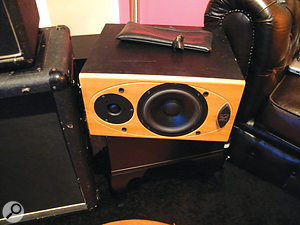 There's no conventional PA: instead, sounds are distributed among four hi-fi speakers scattered around the room. Because they're operating at low level, they don't have to be PA speakers. And the sound is very neutral, and quite often uncompressed — I know John's using quite a lot of effects on the vocals, and some of the other instruments have got processing on, but it's not mastered as you might do a pop record, it's pretty dynamic, the band will range from very quiet passages to something a lot louder.”
There's no conventional PA: instead, sounds are distributed among four hi-fi speakers scattered around the room. Because they're operating at low level, they don't have to be PA speakers. And the sound is very neutral, and quite often uncompressed — I know John's using quite a lot of effects on the vocals, and some of the other instruments have got processing on, but it's not mastered as you might do a pop record, it's pretty dynamic, the band will range from very quiet passages to something a lot louder.”
The need to minimise acoustic reflections explains the quantity of soft furnishings scattered throughout the performance space. "One of the big problems with buildings is that, well, we know about the wall and ceiling reflections, but you also get a lot of floor reflections, and that tends to elevate the 'below' sounds. So, although I might be making sounds at floor level, when you listen to it on the headphones it's about chest level. Without getting too complicated, part of it is due to the ground reflections which, perceptually, lift the sound up. So if you have a fairly dead space with carpeting, it helps, but the ultimate dead space is working outdoors. Some early work I've done with Swimming, and with other artists as well, is to take the artists outdoors into the woods, or into an urban environment where you're in free open space. The great thing about woodland is that you've got rough ground with grass, and that absorbs very strongly.”
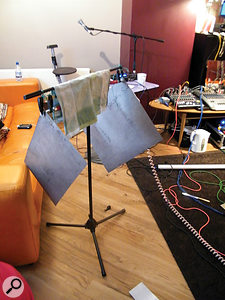 Dallas Simpson's sound objects include suspended sheets of titanium, which can be struck, bowed, flicked, or simply used to provide metallic reflections.Extreme levels are also unhelpful as far as the listener is concerned: "You need to listen at a low level, because if you listen to it loud, the sounds tend to crowd in very close, and you don't get the full spatial separation. If you turn the volume down and listen to it at a lower level, it kind of goes into a bigger space and you start to perceive the distances of things better.”
Dallas Simpson's sound objects include suspended sheets of titanium, which can be struck, bowed, flicked, or simply used to provide metallic reflections.Extreme levels are also unhelpful as far as the listener is concerned: "You need to listen at a low level, because if you listen to it loud, the sounds tend to crowd in very close, and you don't get the full spatial separation. If you turn the volume down and listen to it at a lower level, it kind of goes into a bigger space and you start to perceive the distances of things better.”
Further Focus
For the band as well as the audience, a binaural gig provides a completely different experience from a conventional stage show. "It kind of focuses you,” says guitarist Jonathan 'Joff' Spittlehouse, "because you become more aware of the space you're in. You're thinking 'I'm playing this, that's happening over there, so I should enhance that, or drop out, or...' So it's as focusing at the performance level as it is as a listener. It really emphasises the environment to everyone involved.”
 With minimal 'sound reinforcement' necessary, the main role of the two Soundcraft mixers is to distribute the individual sources among the hi-fi speakers and 'voice pipes' in such a way as to create an interesting 360-degree soundstage within which Dallas Simpson can roam. "When we record conventionally, we like to throw a lot of layers at the mixes, and we want that to come across when we do this, to an extent,” explains singer John Sampson. "The wall, at a conventional gig, is where the speakers are, and you've got very rarely any real stereo imaging happening: it's all one-directional, from us to the audience, with all the layers occupying different frequencies. Now, we've got not just the differences in frequencies with the layers, but we can pan it out in 360-degree space.”
With minimal 'sound reinforcement' necessary, the main role of the two Soundcraft mixers is to distribute the individual sources among the hi-fi speakers and 'voice pipes' in such a way as to create an interesting 360-degree soundstage within which Dallas Simpson can roam. "When we record conventionally, we like to throw a lot of layers at the mixes, and we want that to come across when we do this, to an extent,” explains singer John Sampson. "The wall, at a conventional gig, is where the speakers are, and you've got very rarely any real stereo imaging happening: it's all one-directional, from us to the audience, with all the layers occupying different frequencies. Now, we've got not just the differences in frequencies with the layers, but we can pan it out in 360-degree space.”
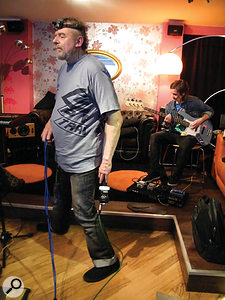 Dallas Simpson's movements during the show are choreographed to bring him into proximity with different 'layers' in the band's sound. In the background here is bassist Blake Pearson. As well as the binaural microphones tucked almost invisibly into his ears, Dallas also wears a head-mounted video camera, which is projected to the audience.
Dallas Simpson's movements during the show are choreographed to bring him into proximity with different 'layers' in the band's sound. In the background here is bassist Blake Pearson. As well as the binaural microphones tucked almost invisibly into his ears, Dallas also wears a head-mounted video camera, which is projected to the audience.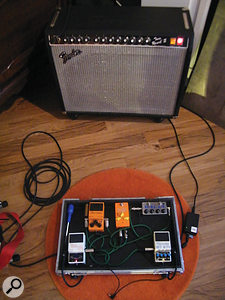 Guitarist Jonathan 'Joff' Spittlehouse's setup is largely unchanged for this show, though you wouldn't know a Fender Twin could sound this quiet!"We change the presentation of the songs, like we're kind of remixing,” adds drummer Pete Sampson. "We just brought out our second album [Ecstatics International, on Tummy Touch Records], and this is part of our album tour, but in this setup, the way that we structure the songs, the feel of the songs, the textures within the songs, all kind of change with this idea of Dallas being the recordist and mixer, doing it live. So all of the songs have a load of different feels. And actually being there performing, we're an abstract concept to the audience, but you're really very aware of the fact that there's an audience listening on headphones. You're quite exposed, because it's such an intimate way for people to listen to it. We set it up so we're all very aware of what each other is doing, but yes, you do actually wonder what is being transmitted through the headphones!”
Guitarist Jonathan 'Joff' Spittlehouse's setup is largely unchanged for this show, though you wouldn't know a Fender Twin could sound this quiet!"We change the presentation of the songs, like we're kind of remixing,” adds drummer Pete Sampson. "We just brought out our second album [Ecstatics International, on Tummy Touch Records], and this is part of our album tour, but in this setup, the way that we structure the songs, the feel of the songs, the textures within the songs, all kind of change with this idea of Dallas being the recordist and mixer, doing it live. So all of the songs have a load of different feels. And actually being there performing, we're an abstract concept to the audience, but you're really very aware of the fact that there's an audience listening on headphones. You're quite exposed, because it's such an intimate way for people to listen to it. We set it up so we're all very aware of what each other is doing, but yes, you do actually wonder what is being transmitted through the headphones!” A hundred and fifty pairs of wireless headphones were hired in for the show.
A hundred and fifty pairs of wireless headphones were hired in for the show.
"It's like a sonic spotlight,” continues John. "He [Dallas] walks searching around the room, and at any point you could be the main sound in the spotlight.”
Boxing Beats
Perhaps the most obvious change in the band's sound that has been made for this binaural gig is to Pete Sampson's setup. Keyboard player Andy Wright usually uses his Apple laptop as the main sound source, so little change was required for this gig.
Keyboard player Andy Wright usually uses his Apple laptop as the main sound source, so little change was required for this gig. 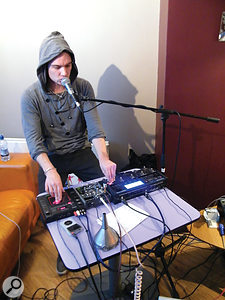 With low volume essential, drummer Pete Sampson switched to beatboxing for the show, using a TC-Helicon VoiceLive 2 and Korg KAOSS Pad to effect and sample his voice respectively. Under normal circumstances, he plays a hybrid kit based around a Roland V-Drum kit with a conventional snare drum, but the low 'stage' volume means that's not an option here. Fortunately, Pete has a sideline as one of the UK's leading beatboxers, and so he's able to provide all the rhythm tracks using a Shure SM58 and a couple of effects processors. "Pretty much all the percussion, apart from a couple of blocks, comes from me. I beatbox, but I'm going through a [TC-Helicon] vocal processing unit with a few effects, a bit of compression, and then that goes through into a [Korg] KAOSS Pad, which is an effects unit that has samplers in it, so I can record my beatboxing at a specified number of beats to a specified tempo, so that's how I'll build up the drums layer by layer and then I can mess around with them and add effects, just mash it up.”
With low volume essential, drummer Pete Sampson switched to beatboxing for the show, using a TC-Helicon VoiceLive 2 and Korg KAOSS Pad to effect and sample his voice respectively. Under normal circumstances, he plays a hybrid kit based around a Roland V-Drum kit with a conventional snare drum, but the low 'stage' volume means that's not an option here. Fortunately, Pete has a sideline as one of the UK's leading beatboxers, and so he's able to provide all the rhythm tracks using a Shure SM58 and a couple of effects processors. "Pretty much all the percussion, apart from a couple of blocks, comes from me. I beatbox, but I'm going through a [TC-Helicon] vocal processing unit with a few effects, a bit of compression, and then that goes through into a [Korg] KAOSS Pad, which is an effects unit that has samplers in it, so I can record my beatboxing at a specified number of beats to a specified tempo, so that's how I'll build up the drums layer by layer and then I can mess around with them and add effects, just mash it up.”
By contrast, bassist Blake Pearson's rig is largely unchanged ("except the volume is much lower!”), as is that of keyboard player Andy Wright: "Mine's just [Apple's] Mainstage with an Akai MPK49 controller, running samplers, mainly. The sounds are slightly tweaked, with a bit more reverb and delay.” The same is true of Joff: "It's pretty much my live rig, but the sounds are different: mostly clean, with varying amounts of delay, a tiny bit of boost and a little bit of drive.”
"For the vocals, we're a bit spoilt tonight,” says John Sampson. "Because the way I sing is quite dynamic, I wanted to squash it down a little bit, so I've got a nice preamp with a compressor built into it, and then for some delays and reverbs we've got an Eventide Eclipse, which is lovely, so we can kind of scatter that around the speakers. And I've got the [Roland] Juno, so I'm multitasking!”
"Because the way I sing is quite dynamic, I wanted to squash it down a little bit, so I've got a nice preamp with a compressor built into it, and then for some delays and reverbs we've got an Eventide Eclipse, which is lovely, so we can kind of scatter that around the speakers. And I've got the [Roland] Juno, so I'm multitasking!”
The Future Now
One of the most encouraging features of Swimming's show is the readiness of the audience to embrace this new method of presentation. As the gig goes on, it's clear that everyone present is getting into the binaural experience, and even though the musicians aren't in the room, the applause at the end leaves no doubt about the success of the endeavour. It's worthwhile validation not only for the band, but for Dallas Simpson, a lifelong evangelist for binaural sound.
"I've got a vested interest in binaural because I've been doing it for years, and I'd like to see it taken up more. It's not just music: the potential for radio drama is phenomenal, and I can't understand why the BBC — despite the fact that they've done a lot of research into binaural in the past — are so reluctant to actually produce some binaural programmes. So if there's something that comes out of this, I hope that it will get the ball rolling to expand its creative use in audio, broadcasting and even film soundtracks.”
For more on Dallas Simpson and his work, visit www.dallassimpson.com.
Down The Pipes
Over the years, Dallas Simpson has developed various techniques for introducing special effects into the binaural sound world. Perhaps the most striking of these are his 'voice pipes': lengths of rigid plumbing pipe with built-in loudspeakers. "It's a Mylar-diaphragm small speaker, about 2.5 Watts, in a pipe housing. Two different lengths of pipe give different resonant frequencies. And with that, I can direct sounds very accurately. The sounds out of the pipe are lo-fi, it's like using filtering, but I can move those sounds in three-dimensional space around me. I call it spatial choreography, because that's what it is, it's movement in space. And that gives that extra dimension to the listening experience.”
These are augmented by a collection of rocks, suspended metal sheets, a musical saw that can be bowed or flicked with fingernails, and so on.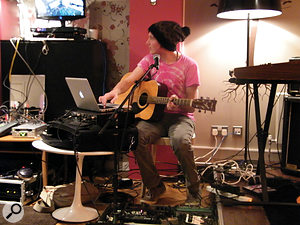 Singer John Sampson brought in quite a bit of gear specially for this show. The small rack beneath his laptop contains a Drawmer 1960 and Eventide Orville used for live vocal processing. As well as playing acoustic and electric guitar, John is also triggering sounds with the laptop keyboard and playing his Roland Juno 60 synth. "I use a number of sound objects: titanium sheets, stones, pieces of wood, and I'll hang those within the performance space. The way we work is that the band will play a number, then there'll be a break, and during that transition between the songs we'll go into a more free soundscape, and in that we'll all improvise, and I will use the sound objects as part of that soundscape, and then it will coalesce into the next song.”
Singer John Sampson brought in quite a bit of gear specially for this show. The small rack beneath his laptop contains a Drawmer 1960 and Eventide Orville used for live vocal processing. As well as playing acoustic and electric guitar, John is also triggering sounds with the laptop keyboard and playing his Roland Juno 60 synth. "I use a number of sound objects: titanium sheets, stones, pieces of wood, and I'll hang those within the performance space. The way we work is that the band will play a number, then there'll be a break, and during that transition between the songs we'll go into a more free soundscape, and in that we'll all improvise, and I will use the sound objects as part of that soundscape, and then it will coalesce into the next song.”
How It All Works
In theory, binaural sound requires only a very simple signal chain, in which a single pair of high-quality microphones are amplified and routed directly to the headphones. However, the choice and positioning of the microphones is crucial. "The ones that I use are DPA 4060 omnidirectional lavaliers,” says Dallas Simpson. "They're very high-quality, with a very good frequency response, and they have a dynamic range of 134dB SPL, so they can accommodate a very wide dynamic range of sound.
"They're actually inserted into the earhole. I must add that in general you should never insert things into your ears, for health and safety reasons, but they're constructed in such a way that they're safe. And I personally modify them so that the out lead comes out of the front of the capsule rather than out of the back, and it's also ultra-thin, 1mm-diameter coaxial wire, which allows them to fit inside my ear — with the normal microphones, the cable's too thick, so if you were to turn the cable round it wouldn't go in your ear.
"The reason I do that is because the whole of your ear structure is a directional filter, and will introduce different phase shifts according to the direction of the sound. If you obstruct the ear cavity, that affects the way the acoustic filter works, so I put them in the earhole, which keeps them out of the way of the ear cavity — so I'm literally sampling my own ears.
"You can use pseudo-binaural techniques, having the microphones outside your ears, which, if you're playing over speakers, is more compatible. A lot of people use pseudo-binaural techniques because of the additional speaker compatibility, but I want to transmit the pure binaural with the full spatial information, which of course is tied into my head/ear/body shape. And that is not so speaker-compatible, but that's the trade-off, and that's why it's a headphone-only concert.”
For those in the audience who choose to watch it, the sense of being 'in' Dallas Simpson's personal space is reinforced by the display from his head-mounted camera. This was custom built by his son Sam, an aircraft engineer, using a camera optimised for low-light conditions. "It presents the listener with my perspective, so they have an orientation within the listening space, and that just helps to focus their visual perception on what I'm doing.”
The simplicity of the binaural signal path is, of course, complicated by the need to distribute the results to 150 people simultaneously. "If we're going to project sound through headphones to the audience, you've got to have the means to do that,” agrees Dallas. "The way we've done it previously is that we'll have a direct hard-wired connection between my ears and the listener [ie. using conventional wired headphones]. The great advantage of that is that we can control the sound quality, and it's pristine. As soon as you go to a radio [wireless] system, you've got the quality of the radio system adding whatever it adds to the quality of the sound, and it's not always as good as you'd like.
"On this occasion, we've got a few hard-wired systems in, so we have a few hard-wired headphone distribution amps, and a few lucky members of the audience — if they think of it that way — can come and plug their headphones in and have the direct link, and they'll get that pristine quality. On the other hand, people with the headsets have got a lot more freedom to wander about if they wish, and that will be a different experience for them. It's all a bit experimental at the moment, really. We're developing this style of presentation and we're adapting it as we go along.”
Commercial Breaks
One of many unusual features of this concert is that audience members will have the opportunity to buy a complete audio and video recording for later download. This sort of commercial exploitation is more usually associated with arena-level shows, but Swimming have worked out some interesting ways to make it possible at a relatively small gig.
"We record it all anyway, because we want to document it,” says John Sampson, "so every camera that's running we're recording — the two still cameras have DV tapes in them, and Dallas is recording his headcam to DV as well, and sonically everything is going to DAT. Someone at our label, Tummy Touch, has kindly put together this system online where they generate 160 codes. We give those codes to people who buy it now, and then when it's all edited and ready to be downloaded, they'll be sent a link to it.”
